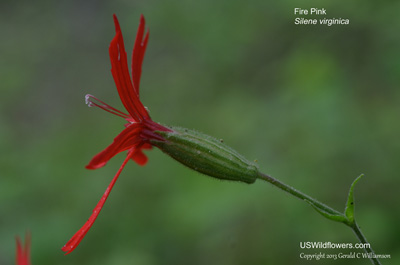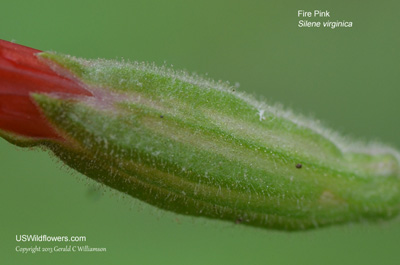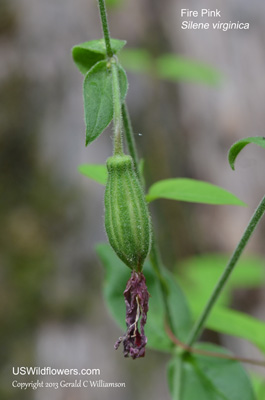Wildflowers of the United States | |||||||||||||
| |||||||||||||
Silene virginica - Fire Pink, Scarlet Catchfly. | Fire Pink has a strikingly beautiful scarlet red springtime blossom. Silene virginica is listed as Endangered or Threatened in Florida, Michigan, and Wisconsin. There are two other Silene species with scarlet flowers and similar ranges - Silene rotundifolia (Roundleaf Catchfly) and Silene regia (Royal Catchfly.) S. rotundifolia has the smallest distribution - AL, GA, KY, OH, TN, WV, with S. regia being found in most those states plus AR, IL, IN, KS, MO (not in WV.) S. virginica has the widest distribution, being found in most of the eastern United States. Royal Catchfly does not have the deeply notched petals of the other two species, and is a taller plant. For the other two species, the stamens and styles are also more exserted in S. virginica than in S. rotundifolia. The veining in the calyx of S. virginica is more distinct. The shape of the flower petals are somewhat different as well, but the leaf shape may be the most obvious difference between the species. S. rotundifolia, as indicated by the species epithet, has much more rounded leaves than S. virginica. Two more scarlet Silene species occur west and south of the eastern scarlet species:
Found in: AL, AR, DE, FL, GA, IA, IL, IN, KS, KY, LA, MD, MI, MN, MO, MS, NC, NY, OH, OK, PA, SC, TN, VA, WI, WV Journal Articles Referencing Catchfly Leave comments on Silene virginica at this link.   Blue=Native; Grey=Introduced Map from USDA Plants Database: USDA, NRCS. 2017. The PLANTS Database (http://plants.usda.gov, 08 May 2025). National Plant Data Team, Greensboro, NC 27401-4901 USA. Search Our Database: Enter any portion of the Scientific, Common Name, or both. Do a general Google search of the entire site: #ad
|
| #ad
| | |||||||||
|
Commercial / Cookie Notice Looking for Wildflowers for a specific state? Check here: | |||||||||||||
|
| |||||||||||||




